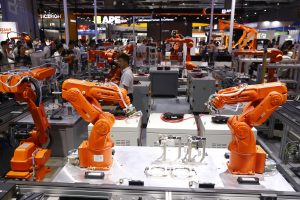In a previous article, I explained that the transition to the autonomy economy – the use of autonomous machines, such as autonomous vehicles, delivery robots, industrial robots, drones, home service robots, etc. to provide goods and services – is the core of the China-U.S. tech competition.
Examining the autonomy economy supply chain, China currently leads in the hardware supply chain of autonomous machines, and possesses significant advantages in batteries, servo motors, sensors, and manufacturing capabilities, but lags behind the United States in essential computing chips powering autonomous machines.
The development of computing chips for autonomous machines, dubbed autonomous machine computing (AMC), is China’s only missing link in completing its self-reliant autonomous machine ecosystem.
The semiconductor industry is the key enabler of a modern economy. The growth of an emerging economy, such as the autonomy economy, will incentivize the semiconductor industry to develop enabling technologies – and the newly developed enabling semiconductor technologies will in turn boost the growth of the emerging economy, thus forming a virtuous circle. Therefore, the country that dominates the enabling semiconductor technology will dominate the coming economic era.
Looking back at information technology history, personal computing has been mainly powered by affordable microprocessors designed and manufactured by companies such as IBM, Apple, and Intel. Mobile computing has been mainly powered by system-on-chips designed by Apple, Qualcomm, and Broadcom. Cloud computing has been mainly powered by server processors designed by Intel, AMD, Nvidia, and, more recently, Google’s TPU. All these companies are American, therefore enabling the United States to dominate these economic eras.
A 2022 strategic document published by the Chinese Academy of Engineering provides key insights into China’s strategy for breaking that pattern. The document focuses on achieving self-sufficiency in AMC solutions in order to sustain China’s continuous technological transition to the autonomy economy. The plan has four parts: First, elevate AMC to national strategic importance and establish a central government leadership group dedicated to steering the development of AMC. Second, leverage national laboratories, engineering research centers, and other platforms to pool resources and expertise for effective research and development. Third, implement talent plans to attract and develop AMC talents. Fourth, prioritize and incentivize the commercial development of key areas such as chip design, processing, industrial integration, and application.
The overall objective is for China’s AMC industry to achieve enhanced capabilities by 2025, global leadership by 2030, and complete dominance by 2035.
Historically, China’s national industrial policy has worked quite effectively. For instance, to boost the development of the intelligent electric vehicle (IEV) industry, the Chinese government committed enormous amount of financial resources. After a decade of intensive investments, China now not only owns the most sophisticated IEV supply chain but is also the biggest IEV market in the world. If China decided to elevate AMC to national strategic importance, we could see similar success within the next decade.
Indeed, facing U.S. curbs on AI chip exports to China, the Chinese government has already poured billions of dollars into its semiconductor industry, aiming for semiconductor self-sufficiency. In 2022 alone, the Chinese government provided 190 chip firms $1.75 billion in subsidies to boost their R&D and manufacturing capabilities.
China today is already the biggest manufacturing country and the biggest market of autonomous machines. For instance, each year, the global sales of robot vacuums totals 15 million units; of those, more than 10 million units are manufactured in China. Over the past five years, Chinese robot vacuum manufacturers have swept global rivals with their advanced technologies and low prices. A few years ago, most of the robot vacuums were powered by computing chips provided by U.S. semiconductor companies such as Qualcomm and Texas Instruments. Today, most of the robot vacuums manufactured in China are powered by computing chips provided by Chinese semiconductor companies such as Allwinner and Rockchip. In other words, China has already achieved semiconductor self-sufficiency in the low-end AMC market.
In the high-end AMC market – for instance, the chips powering IEVs – U.S. semiconductor companies still dominate but Chinese semiconductor companies are catching up rapidly. In 2022, China manufactured 5.5 million IEVs, whereas the global sales of IEVs is 10 million units. Most IEVs manufactured in China are still powered by computing chips provided by Qualcomm for smart cockpit, by Texas Instruments and Nvidia for assisted and autonomous driving.
Nonetheless, for their next generation of IEV products, more and more Chinese OEMs have announced they will utilize domestic computing solutions provided by Huawei or Horizons Robotics. Several leading Chinese IEV manufacturers, including NIO, Li Auto, and XPeng, also announced their plans to develop proprietary computing chips in order to achieve AMC self-sufficiency.
Washington has imposed strict export restrictions on artificial intelligence-related chips aiming to suppress the development of China’s tech industry. These measures may be effective in the short term but potentially counterproductive in the long term, as these restrictions may act as a catalyst to force the Chinese government to elevate AMC to national strategic importance.
Today, China contributes to 27 percent of Intel’s revenue, and 25 percent of Nvidia’s revenue. If China possessed world-leading AMC technologies, not only would U.S. semiconductor companies lose a significant market share, but also China would be able to develop advanced autonomous machines that potentially outperform U.S. counterparts. As emphasized in the latest warning issued by Nvidia, further U.S. export curbs on its chips to China would risk a “permanent loss” for American semiconductor firms to lead in one of the world’s largest markets.
In summary, AMC is China’s only missing link in completing its self-reliant autonomous machine ecosystem. In the low-end autonomous machine market, such as robot vacuums, China manufactures over two-thirds of world’s supply and has achieved AMC self-sufficiency. In the high-end autonomous machine market, such as IEVs, China manufactures half of the world’s supply and is investing heavily with the aim of achieving AMC self-sufficiency. The United States’ curbs on AI chip exports to China may act as a catalyst for the Chinese government to elevate AMC to national strategic importance.

































